![]()
A “sustainable PC” might not top your buying criteria. But a low-power, repairable PC might. Both go hand-in-hand, HP’s Alex Cho says.
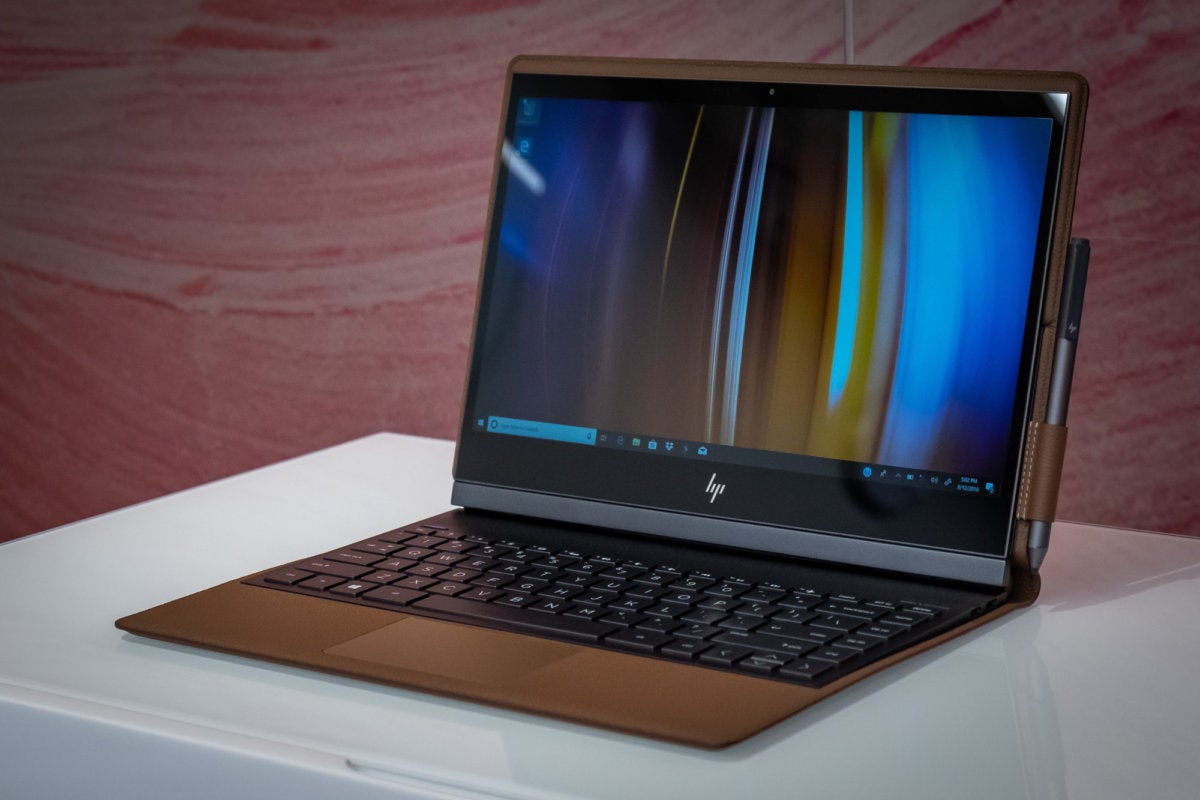
In May, HP claimed that it now offered the “most sustainable” PC portfolio. Alex Cho, the president of its Personal Systems Group, spoke with PCWorld’s Mark Hachman to explain why sustainability, materials, and saving power is important even during a pandemic and high unemployment. Below is a transcript of the conversation, edited for space and clarity.
PCW: HP claims that it offers the most sustainable PC portfolio. I would ask: Why now? Why should people care, when so much else is going on in their lives?
Cho: Within personal systems, it’s been particularly important for us. Because it’s not a one-hit wonder. It’s not with one generation. We have been working on this across our portfolio of PCs, all of the accessories and displays, as well as thinking about how it relates to our service business and our thinking about packaging.

HP HP’s Alex Cho.
I would set the context that this is a journey for us. And then fast-forward to where we are today in a world of COVID. Everyone is working through it. We don’t think that it should pause the importance of thinking about the impact that we make, as we are designing solutions.
Sustainability is about three pillars. We’ve talked about people, planet, community—so we don’t just think about the product. And there has never has been a better time for people to recognize that the world is more connected than not.
PCW: Let’s define what sustainability means as far as a PC is concerned. What is it?
Cho: It includes the product itself—the type of impact that it makes, whether it’s focused on enabling more use of more post-consumer recycled plastics. We think about greenhouse-gas emissions, we think about not just the product, but the process that that was used to make it as well as the packaging. We do roughly 16 million PCs alone a year, and so packaging is very important, and so we think about single-use plastic packaging. That’s kind of the planet side of this topic.
We also care a lot about communities. Focusing on education around the world is very important because we don’t want to just create something, we want to help it solve problems, and help them to be used for learning. So that’s another way. Again, for us, it’s holistic.
PCW: Can you give me a sense for how much HP itself contributes, versus your suppliers? HP takes motherboards and components and assembles them together inside of an HP-branded chassis. So how much of this is HP’s responsibility?
Cho: We actually think it’s very much HP’s responsibility, but also something that the value chain participates in. But what do we do that is uniquely ours? The packaging is a decision that we make in the structural material compositions. We announced the world’s first use of ocean-bound plastics, whether might be our Elite Dragonfly notebook, or the use of ocean-bound plastics in the first display that uses them. And that’s a choice that we make on materials. Now we have them in our workstations. So that’s definitely decisions and levers that we own in the process.
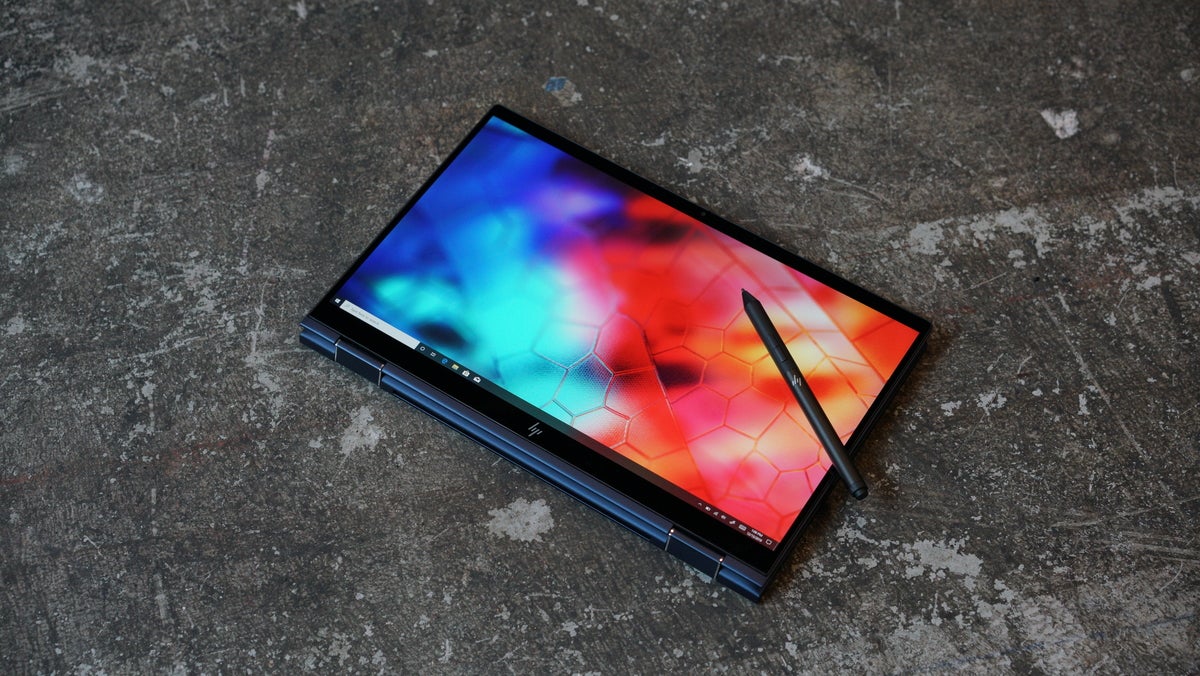
Gordon Mah Ung HP’s Elite Dragonfly.
When I talk about greenhouse gas emissions, you know, a lot of this is around decisions that we make on the amount of power consumption and energy efficiencies that we architect into it. By the way, in a time of COVID, where you are computing more, you want longer battery life and you want more efficient performance.
PCW: I want to talk about those more in a bit. But let’s just focus on packaging for a second. How has packaging evolved from, say, 10 years ago?
Cho: We are changing in multiple areas: Moving away from styrofoam, looking at more simple-use plastic packaging, as well. Being very thoughtful about the overall dimensions, and the amount, and designing the overall package. We have to design for this because they are sensitive components. We want to ensure that they withstand the demands of logistics.
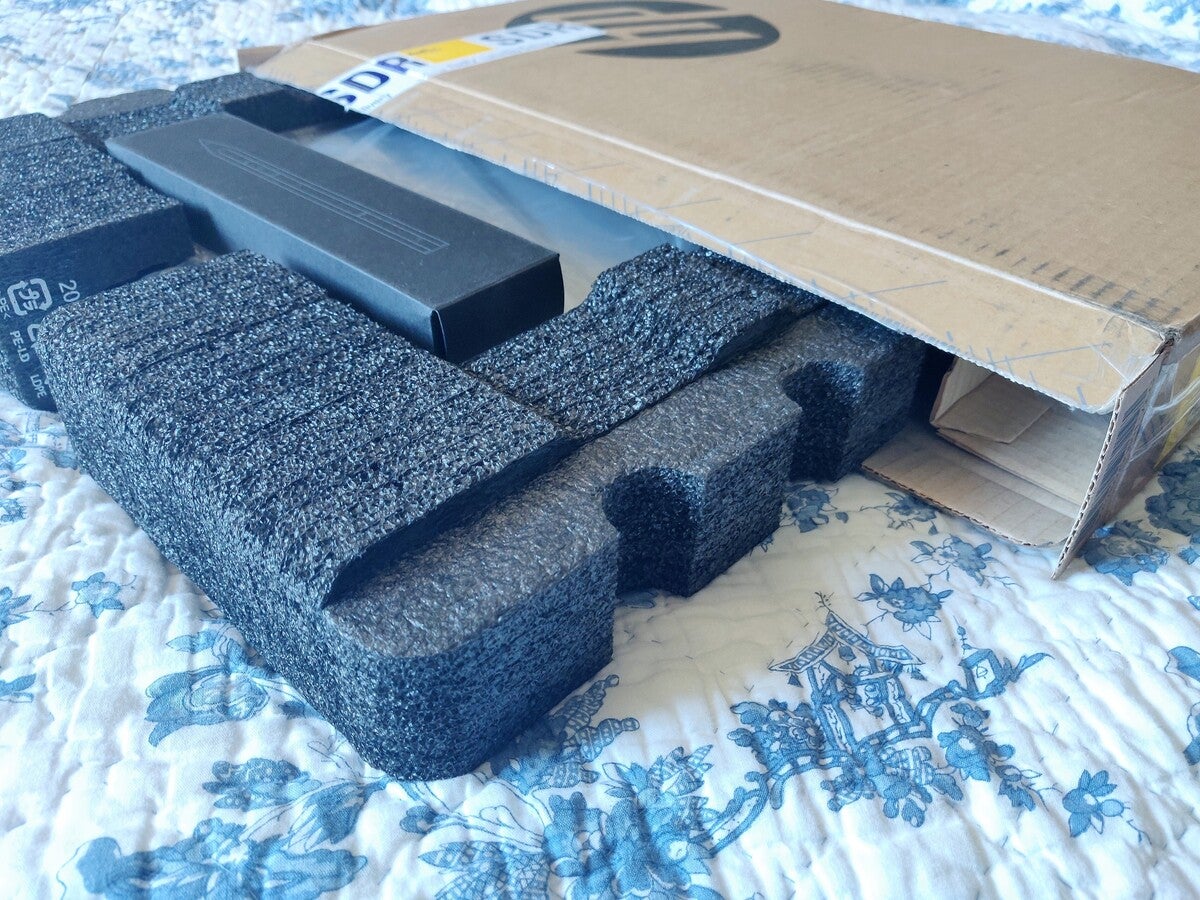
Mark Hachman / IDG The interior packaging of an HP Pavilion review unit sent to PCWorld, as it emerges from the box. Note how the cardboard to the lower right is folded to create space.
We’re very much focused on the materials. You’ll see different materials, you’ll see the construction of our packaging differ, but we also think about usability and the whole unboxing experience.
PCW: PCs have changed, from all-plastic iMacs to now, where metal is much more integral to the design. One example is the HP Elite C1030 Chromebook Enterprise, which is made from 75 percent recycled aluminum. Can you talk a bit more about why more notebooks are designed around metal?
Cho: Materials—both from the perspective of sustainability, but also related to experience on the device—play into all of that, as well as cost. We are increasingly using advanced materials that meet the properties of all three of those areas, like you explained about our Chromebooks.
We look at our Elite Dragonfly notebook. What did it do? It? We moved to 80-percent recycled materials in that, using magnesium. We also have achieved new breakthroughs on weight: It’s one kilogram, as a business convertible. And we’re delivering it in new colors that meet the reality between your professional device and your personal device. They’re often intermixed.
PCW: Where do you get your recycled materials from? How does that process actually work?
Cho: We have a supply chain that that we work with, in terms of sourcing materials.
PCW: If I’m a consumer, and I believe in recycling, how do I contribute to this? There’s a tradition of taking aluminum cans down to a recycler when we’re done with them. How do we get consumers used to doing that with PCs? I know HP does have recycling programs, but they seem to be more geared toward recycling inkjet cartridges.
Cho: We see it as a multi-step, value-chain topic. You know what we’ve already covered, around designing more sustainable components in our product. So that’s part of it. And there’s a lot of different dimensions to that.
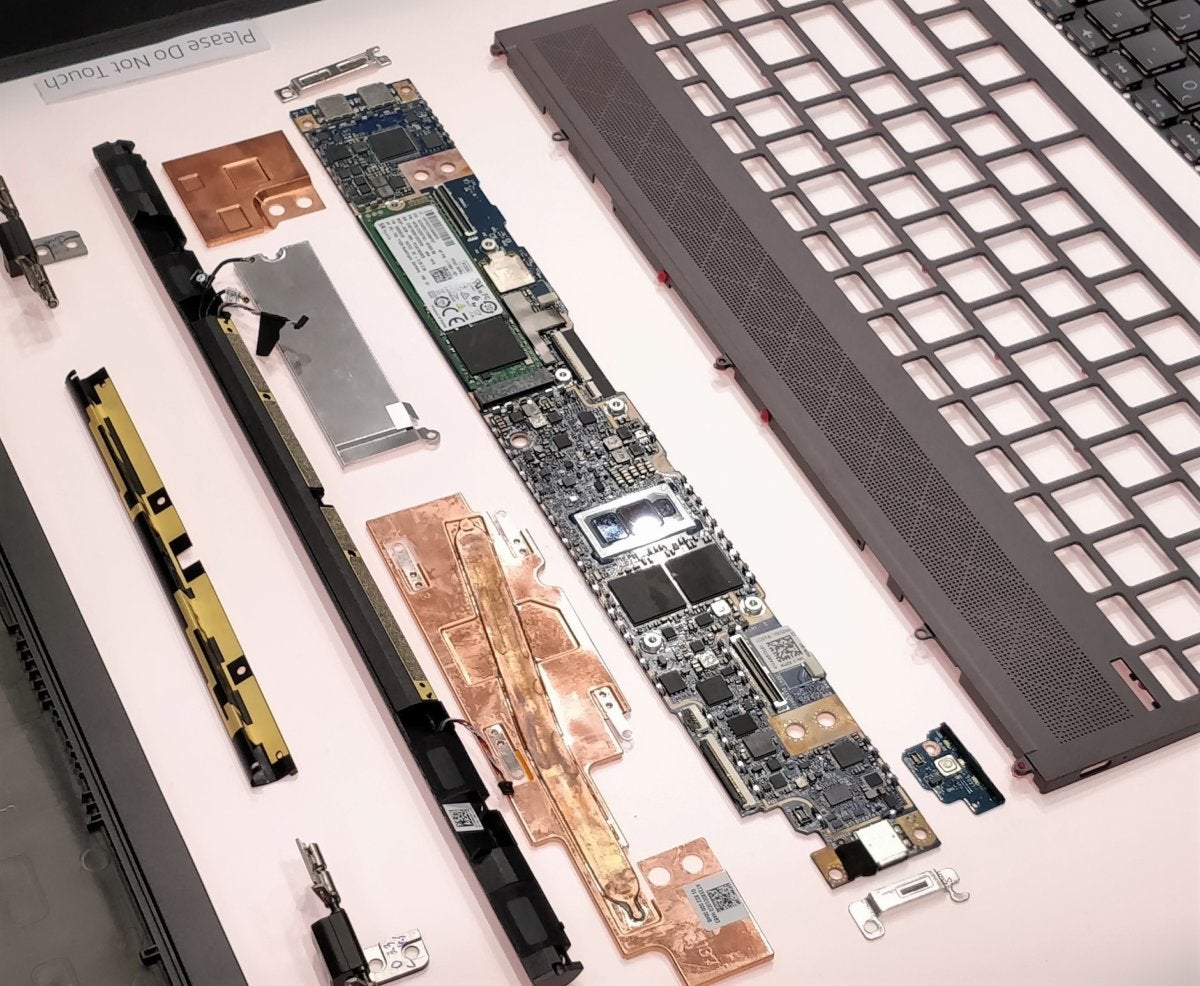
Mark Hachman / IDG The motherboard and other components within HP’s Spectre Folio.
Obviously, there’s a huge element also around designing for serviceability. With other products out there, if you have an issue with the product, you can’t use it anymore. So we really designed for serviceability that reduces the amount of additional [environmental] impact. We look at features like how well can you replace a screen. We look at [repair] scores from iFixit as one proxy for us.
We’re increasingly moving to a services business where I can take [a PC] back. A 360-degree program is important, because we’re finding customers have needs that evolve. We can create more of a closed-loop process by which we enable them to bring those back. We have a service offering, and entrance into the broader [recycling] ecosystem. That also contributes. We think of it in multiple parts of the ecosystem, because it’s really not a silver bullet.
PCW: Do you think we’ll ever transition to a model where PCs aren’t just left on a shelf there to rot, but after a period of five or six years we’ll take them down to a recycling center or send them back to the manufacturer in exchange for a fee?
Cho: Yeah, you already see some of that happening. It’s about location. And I think that is definitely a larger ambition, about participating in a much larger ecosystem about that being done. And that’s why I say that COVID is definitely impacting the world in challenging ways. We don’t see any reason why the need and the value proposition to customers and to the planet should stop us from making progress. We’re very excited. It’s a very rewarding part of what we do in terms of what we call personal systems.
PCW: One of the ways that HP has justified its sustainability claims is the number of certified EPEAT Gold and Silver products. Two of the criteria used in awarding those specifications are product longevity and energy efficiency. Let’s talk about the first. In everything we hear—from Intel, say, and other PC makers—longevity is the enemy. You want us to replace older PCs every five years or so. This seems counterintuitive to what EPEAT promotes. Is it?
Cho: I would say no. We look at two dimensions. One is that we want to make sure that customers continue to have computing experiences that are relevant for current needs. And so there’s natural cycles of innovation to make sure that they’re getting that.
At the same time, we really believe in having an ongoing value proposition for the customer. For some, their lifecycles might be longer; some might be shorter. And in fact, through offerings like device-as-a-service, we’re able to customize that and tailor it more to the unique needs of our customer. We’re not just about PC hardware, it’s about experiences. We want to make sure that [consumers] are the ones who are getting the benefits, whether that be in working remotely, gaming and entertainment, or to even think about healthcare—a number of visits that are happening via some kind of telehealth type of infrastructure.
One more thing that I would add is that in every generation of our products, because we’re so focused on this, it gets more efficient. Every generation, we should make more progress.
PCW: Energy efficiency is another important thing to talk about, especially because it has an effect on the total cost of ownership of a PC and a user’s energy bills. How have HP’s PCs evolved in terms of energy savings, and where do you see them headed in the future?
Cho: Just to give you some data points, we looked at one of our commercial desktops a few years ago, and we looked at where we are today. We’re 30 percent better, 30 percent less [power], that’s on a desktop.
Notebooks as well: The mission is to deliver energy efficiencies across our products. An Elitebook compared to a few years ago versus now, we’ll see 30-percent [power savings] on our current model versus the equivalent model just a few years ago. We look at it similarly across the portfolio. We think that continuing on this path will will be very fruitful as we make progress on our overall sustainability missions.
PCW: You talked about this before as more of a holistic problem. Can you address the issue of power savings via Windows features like modern standby, and HP’s own services, as well as hardware?
Cho: We explicitly look at hardware, software and services. On the hardware side, obviously, it’s the material, as we talked about, but also the efficiency of the architecture. That’s part one. Software is also very important. You talked about a few things: modern standby, you know, enabled by Windows. Also, increasing AI, and algorithms that we use in order to optimize the performance of the device that’s being used, when you need it to be used. Think about things like GPUs and CPUs, and making sure that we’re optimizing when we’re using them.
Services: we talked a little bit earlier around enabling users to [recycle] PCs. We’re also able to remotely identify when devices might have failures. So being able to remediate that ahead of time is important.
Failure doesn’t necessarily mean the device breaks. It might mean that something is running, running, running, running, consuming a lot more energy than it needs to. We look at that, at all parts of how we contribute, across hardware, software, and services.
PCW: This is somewhere between lifestyle and sustainability. One of the choices HP has made has been in the use of materials like leather to wrap devices like the HP Spectre Folio. What do you think about when you’re making those decisions, and where do we go from here?
Cho: It’s a great time to be in this business. Because we’re able to really explore a huge array of materials. Maybe I can just share with you what the criteria are.
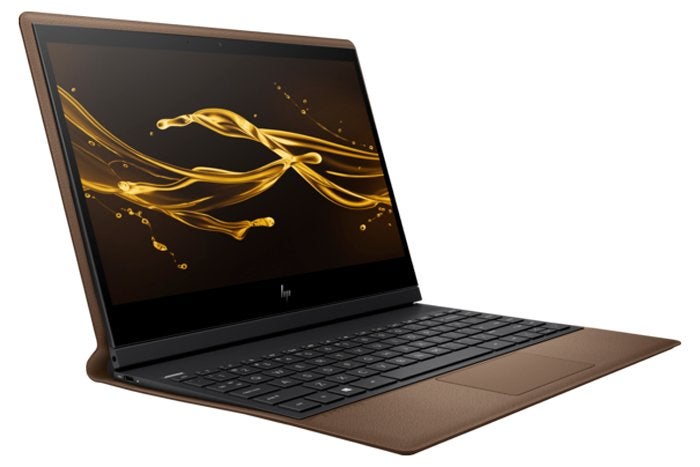 HP
HPHP’s Spectre Folio, which sheathes the laptop in leather.
We do look at performance. That’s very important. Those who are in this business know about thermal performance efficiencies. We also definitely look at sustainability issues. And we also look at the experience of the product, both how it feels, but also how it looks. These devices—they’re very personal devices, whether for work or for personal use, and they make a statement. We’ve actually invested a lot in exploring different types of materials. You’ve seen some of them today.
One of the things that I would highlight is that we recognize that computing is increasingly a part of people’s lives. And so, why not explore things like wood? Why not explore things like leather? Why not look at other types of materials that are not traditionally thought of in terms of computing—they’re warmer, they’re a little bit more reflective [of life] outside of technology.
We really believe in bringing technology to people as a design center. We don’t want to just take technology and shove it at people. We really believe in a human design focus, bringing technology to personalize it and meet where people are. So that kind of design center is giving us opportunity to explore a rich set of things: colors, materials, finish. It’s a very exciting area at this company.
PCW: Final question: Where do we go from here?
Cho: COVID is an interesting—to use one adjective—time. It is very difficult for the world of computing.
I will say that other than the challenges of working in this environment, we really think that now is a catalyst for a whole lot of new things, highlighted by the fact that the PC is essential. I remember, not too long ago, when some people told me, hey, the PC is dead. I have four kids, and they’re not in school unless they have a PC. So are the other billion children around the world not in a classroom.
Because of that we see remote-distance type of environments as a real catalyst for brave new innovations that are meaningful for customers. We’re very energized by that. We have been working on several things for several years. We just had a fast-forward opportunity to test them in the world because of the current environment. So I would expect a lot more.
It’s a very exciting time to be in this business. Right now everyone is feeling a little bit disoriented. Computing can bring a lot of value, because it really is essential now, and that’s why we are working as hard as we can.
Contact Information:
Mark Hachman
Tags:
, Wire, United States, English
Contact Information:
Mark Hachman

